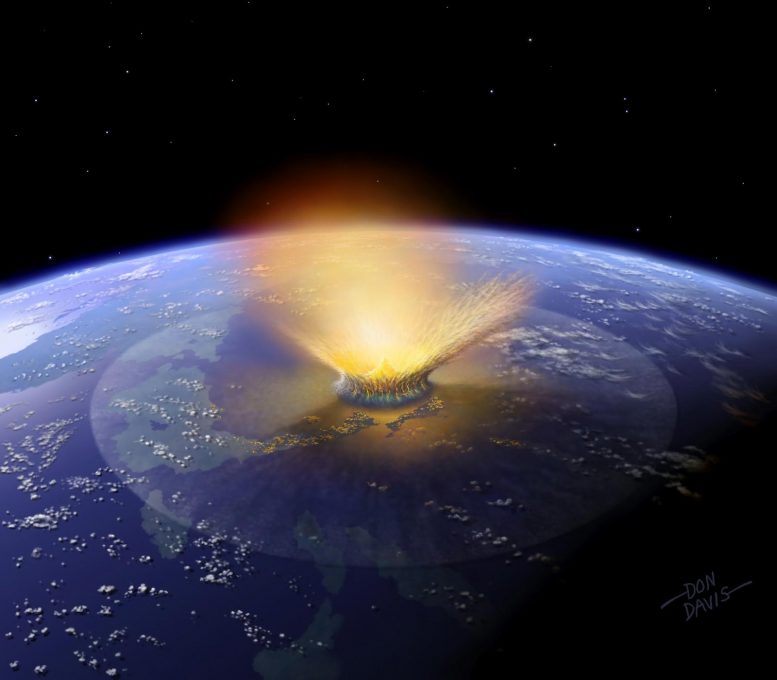What if a 10 km (6.5 mile)-wide asteroid was on a bee-line towards Earth, with an impending, calamitous impact just six months away? This was the scenario in the recent Netflix film, “Don’t Look Up.” The movie has led many to wonder if we have the resources and technology ready and available today to avert such a disaster.
A new paper looking at the technical aspects of such an endeavor says yes. Yes, we do.
“We show that humanity has crossed a technological threshold to prevent us from ‘going the way of the dinosaurs’,” wrote Philip Lubin and Alex Cohen, researchers at the University of California Santa Barbara, in their paper posted reecntly on Arxiv. “We show that mitigation is conceivable using existing technology, even with the short time scale of 6 months warning.”
As a cautionary note, they added that the dinosaurs “never took a physics class and failed to fund planetary defense.”

Don’t Look Up (L to R) Leonardo DiCaprio as Dr. Randall Mindy, Jennifer Lawrence as Kate Dibiasky. Credit: Niko Tavernise/Netflix © 2021asteroid gif
Similar to articles we’ve published previously on Universe Today, this new paper looks at several different ways that have been devised to divert an asteroid, but they focus mainly on various explosive penetrators for the “Pulverize It” (PI) method.
The duo concludes that the most effective method of pulverizing is using small nuclear explosive devices (NED) in the penetrators. This, combined with soon-to-be-realized heavy lift launch assets such as NASA’s Space Launch System (SLS) or SpaceX’s Starship (with in-orbit refueling) is sufficient to mitigate this existential threat.
This method would not completely obliterate an asteroid – which is virtually impossible for an asteroid that size. But it would vaporize part of the asteroid’s surface, generating an explosive thrust and a change in velocity in response. This would change the asteroid’s path, hopefully diverting it from hitting our planet.
That we have the technology available today is actually not a controversial opinion. We have discussed the topic with Apollo astronaut Rusty Schweickart – who helped found the asteroid research organization B612. Schweickart has emphasized that the technology needed to divert an asteroid exists today.
“That is, we do not have to go into a big technology development program in order to deflect most asteroids that would pose a threat of impact,” he said, but added that the technology had not been put together in a system design, or tested and demonstrated that it could actually deflect an asteroid.
But that is about to change. Late last year, NASA launched the Double Asteroid Redirection Test (DART), the first-ever planetary defense test mission. It will demonstrate that a spacecraft can autonomously navigate to and perform a kinetic impact on a relatively small target asteroid. This will test if this is a viable technique to deflect a genuinely dangerous asteroid.

Artist’s impression of NASA’s Double Asteroid Redirection Test (DART) spacecraft speeding toward the smaller of the two bodies in the Didymos asteroid system. Credit: NASA/Johns Hopkins University Applied Physics Laboratory
While a “planet killer” event is quite rare, of order once per 100 million years, it is likely a matter of when, not if.
The paper by Lubin and Cohen notes that a threat of this magnitude hitting the Earth at a closing speed of 40 km/s would have an impact energy of roughly 300 Teratons TNT, or about 40 thousand times larger than the current combined nuclear arsenal of the entire world.
“This is similar in energy to the KT extinction event that killed the dinosaurs some 66 million years ago. Such an event, if not mitigated, would be an existential threat to humanity,” they said. “We show that mitigation is conceivable using existing technology, even with the short time scale of 6 months warning, but that the efficient coupling of the NED energy is critical.
In a thought experiment, they also looked at what would be needed to divert an asteroid the size of Texas, approximately 830 km diameter. This is about the size of the dwarf planet Ceres.
“What do you do now?” they asked. “You are going to need some die hard to get you out of this one. A couple of options: a) party, b) move to Mars or the Moon to party, c) do what they did in Chicken Run during take-off.”
Kidding aside, they said the purpose of their paper was to show that even in relatively extreme short-term warning cases we’d have the ability to respond, but only if we prepare – which Schweickart and B612 have repeatedly and vociferously advocated.
“Though the numbers may seem daunting, it is not outside the realm of possibility even at this point in human technological development,” Lubin and Cohen said. “This gives us hope that a robust planetary defense system is possible for even short notice existential threats such as we have outlined. Ideally, we would never be in this situation, but better ready than dead.”
Originally published on Universe Today.














